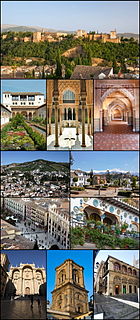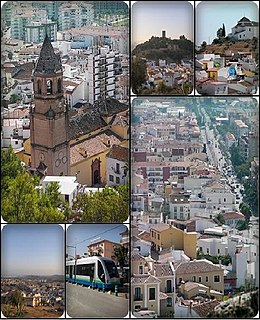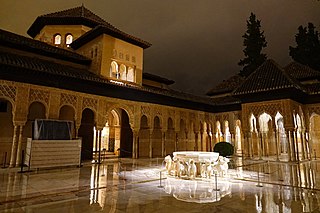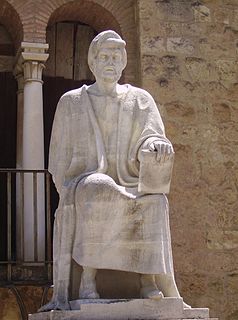
The Alhambra is a palace and fortress complex located in Granada, Andalusia, Spain. It was originally constructed as a small fortress in 889 CE on the remains of Roman fortifications, and then largely ignored until its ruins were renovated and rebuilt in the mid-13th century by the Nasrid emir Mohammed ben Al-Ahmar of the Emirate of Granada, who built its current palace and walls with many beautiful, intricate details. It was converted into a royal palace in 1333 by Yusuf I, Sultan of Granada. After the conclusion of the Christian Reconquista in 1492, the site became the Royal Court of Ferdinand and Isabella, and the palaces were partially altered in the Renaissance style. In 1526 Charles I & V commissioned a new Renaissance palace better befitting the Holy Roman Emperor in the revolutionary Mannerist style influenced by humanist philosophy in direct juxtaposition with the Nasrid Andalusian architecture, but it was ultimately never completed due to Morisco rebellions in Granada.

Granada, locally [ɡɾaˈna] is the capital city of the province of Granada, in the autonomous community of Andalusia, Spain. Granada is located at the foot of the Sierra Nevada mountains, at the confluence of four rivers, the Darro, the Genil, the Monachil and the Beiro. Ascribed to the Vega de Granada comarca, the city sits at an average elevation of 738 m (2,421 ft) above sea level, yet is only one hour by car from the Mediterranean coast, the Costa Tropical. Nearby is the Sierra Nevada Ski Station, where the FIS Alpine World Ski Championships 1996 were held.

Vélez-Málaga is a municipality and the capital of the Axarquía comarca in the province of Málaga, in the Spanish autonomous community of Andalusia. It is the most important city in the comarca. Locally it is referred to as Vélez. Vélez-Málaga is the headquarters of the Commonwealth of Municipalities of Costa del Sol-Axarquía. The municipality forms part of the Costa del Sol region.

The Nasrid dynasty was the last Muslim dynasty in the Iberian Peninsula, ruling the Emirate of Granada from 1230 until 1492. The Nasrid dynasty rose to power after the defeat of the Almohad Caliphate in 1212 at the Battle of Las Navas de Tolosa. Twenty-three emirs ruled Granada from the founding of the dynasty in 1230 by Muhammad I until 2 January 1492, when Muhammad XII surrendered all lands to Queen Isabella I of Castile. Today, the most visible evidence of the Nasrid dynasty is part of the Alhambra palace complex built under their rule.

The Court of the Lions (Spanish: Patio de los Leones; Arabic: بهو السباع) is the main courtyard of the Nasrid dynasty Palace of the Lions, in the heart of the Alhambra, the Moorish citadel formed by a complex of palaces, gardens and forts in Granada, Spain. It was commissioned by the Nasrid sultan Muhammed V of the Emirate of Granada in Al-Andalus. Its construction started in the second period of his reign, between 1362 and 1391 AD. The site is now part of the UNESCO World Heritage List and minted in Spain's 2011 limited edition of 2 € Commemorative Coins.

Islam was a widespread religion on the Iberian Peninsula, beginning with the Umayyad conquest of Hispania and ending with its prohibition by the modern Spanish state in the mid-16th century and the expulsion of the Moriscos in the early 17th century, an ethnic and religious minority of around 500,000 people. Although a significant proportion of Moriscos returned to Spain or avoided expulsion through forced conversion to Christianity, the practice of Islam had faded into obscurity by the 19th century.

The Albaicín or Albayzín as it was known under Muslim rule, is a district of Granada, in the autonomous community of Andalusia, Spain. It retains the narrow winding streets of its Medieval Moorish past dating back to the Nasrid Kingdom of Granada. It was declared a World Heritage Site in 1984, along with the Alhambra.

Moorish architecture, is an architectural style which historically developed in the western Islamic world, which included al-Andalus, Morocco, and much of Algeria, Tunisia, and Libya. The term "Moorish" comes from the European designation of the Muslim inhabitants of these regions as "Moors". Scholars often use "Western Islamic architecture" or "architecture of the Islamic west" as more descriptive or neutral terms for this topic.
Emilio García Gómez, 1st Count of Alixares was a Spanish Arabist, literary historian and critic, whose talent as a poet enriched his many translations from Arabic.

San Sebastian is a redundant church in Toledo, Spain. The building was originally a mosque and was converted for use as church after the Reconquista. It is protected by the heritage listing Bien de Interés Cultural.

Abu al-Hajjaj Yusuf ibn Muhammad was sultan of the Emirate of Granada, the last Muslim state in the Iberian Peninsula, from January 1391 until his death. He was the 11th sultan of the Nasrid dynasty and the first son of his predecessor, Muhammad V.
Al-Udri or Al-Udhri, was an Arab Geographer, traveler and historian of al-Andalus. He hailed from the Arab tribe of Udra which had settled Almería.
Antonio Domínguez Ortiz was a Spanish historian, one of the leading specialists in the history of the Spanish Antiguo Régimen of the 16th through 18th centuries, in particular in social history. He was also expert historian of Andalusia, with a particular emphasis on the history of the Moriscos.

The Gate of the Ears, also known as the Arc of the Ears or Bib-Arrambla Gate, was a city gate of Granada. Built in the 11th or 12th century, it stood at the corner of Plaza de Bib-Rambla and Calle Salamanca. During the 19th century, the gate became the subject of several major controversies, and in 1884 it was demolished.

The Palacio de Xifré is a Madrilenian palace now disappeared that was in the Paseo del Prado, at the corner Calle de Lope de Vega, opposite of the Prado Museum. It was one of the best examples of Neo-Mudéjar architecture in Madrid and one of the palaces that the Spanish financial elite of the second half of the 19th century had built along the paseos del Prado, Recoletos and la Castellana.

Manuel Gómez-Moreno González was a Spanish painter, amateur archaeologist and professor. His son was the noted historian and archaeologist, Manuel Gómez-Moreno Martínez.
María Teresa Martín-Vivaldi García-Trevijano is a Spanish painter.
Fatima bint Muhammad "bint al-Ahmar" was a Nasrid princess of the Emirate of Granada, the last Muslim state on the Iberian Peninsula. A daughter of Sultan Muhammad II and an expert in the study of barnamaj, she married her father's cousin and trusted ally, Abu Said Faraj. Their son Ismail I became sultan after deposing her half-brother, Nasr. She was involved in the government of her son but was especially politically active during the rule of her grandsons, Muhammad IV and Yusuf I, both of whom ascended the throne at a young age and were placed under her tutelage. Later Granadan historian Ibn al-Khatib wrote an elegy for her death stating that "She was alone, surpassing the women of her time / like the Night of Power surpasses all the other nights". Modern historian María Jesús Rubiera Mata compared her role to that of María de Molina, her contemporary who became regent to Castilian kings. Professor Brian A. Catlos attributed the survival of the dynasty, and eventual success, as being partly due to her "vision and constancy."

The documented history of Murcia traces back at least to the Middle Ages, after Madinat Mursiya was built by Andalusi Emir Abd al-Rahman II in the 9th century, while it is suggested the city was erected over a previous settlement of Roman origin.

The Ayuntamiento de Granada is the institution charged with the government and administration of the Spanish municipality of Granada.

















